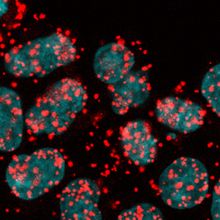Login
Subscribemicrobiology

Mutated Cohesin Throws DNA Splicing out of Whack, Resulting in Cancer
Shafaq Zia | Mar 3, 2023 | 2 min read
Cohesin mutations cause dysregulations in alternative splicing, contributing to tumor initiation and progression, a study finds.

Now AI Can Be Used to Design New Proteins
Kamal Nahas, PhD | Mar 3, 2023 | 4 min read
Machine learning can be harnessed to synthesize artificial light-bearing enzymes that actually work in cells.

The Advantages of 3-D Cell Culture
MilliporeSigma | 1 min read
3-D cell culture narrows the gap between in vitro and in vivo.

How Genes from Neanderthals Predispose People to Severe COVID-19
Alakananda Dasgupta | Feb 22, 2023 | 4 min read
Researchers dissect the Neanderthal-derived region on chromosome 3 that drives severe COVID-19 to zero in on the key causal variants.

Gut Microbiomes Offer Insights into Chronic Fatigue Syndrome
Shafaq Zia | Feb 21, 2023 | 2 min read
Levels of health-promoting gut bacteria are linked with severity of fatigue symptoms, a study finds.

Are Your Cell Lines What You Think They Are?
MilliporeSigma | 1 min read
Learn how to identify contamination and authenticate your cell lines.

Science Falls Behind as Syphilis Stages Another Comeback
Bhargavi Duvvuri, Undark | Feb 21, 2023 | 6 min read
Syphilis is among the oldest known sexually-transmitted infections. Scientists still struggle to detect and treat it.

Bacteria Have Histones After All: Study
Kamal Nahas, PhD | Feb 14, 2023 | 4 min read
Researchers identify hundreds of candidate histone proteins in bacteria, including one with an unusual way of binding to DNA.

Why Might Cells Die or Fail to Thrive in Culture?
MilliporeSigma | 1 min read
Learn more about cell culture best practices.

Giant Viruses Grew Out of Small Ones: Study
Kamal Nahas, PhD | Feb 13, 2023 | 4 min read
A study employing CRISPR/Cas9 to explore the evolutionary beginnings of some giant viruses finds evidence their large genomes arose from gene duplications.

Drugs Hitch a Ride on Algae for Targeted Delivery
Holly Barker, PhD | Feb 1, 2023 | 3 min read
A new microrobot uses algae to transport antibiotics into the lungs of mice with pneumonia.

Wastewater’s Hidden Value for Monitoring Public Health
The Scientist’s Creative Services Team and Bio-Rad Laboratories | 1 min read
Learn about wastewater-based epidemiology—from its conception to its present state and into its future.

Infographic: Algae Robots Transport Antibiotics to Infected Tissues
Holly Barker, PhD | Feb 1, 2023 | 1 min read
Microscopic algae dotted with drug-filled nanoparticles may offer a more effective means of treatment than traditional delivery methods.

Mitochondrial Metabolism Dictates Neurons’ Growth Rate
Katherine Irving | Jan 30, 2023 | 4 min read
Altering the rate of respiration in mitochondria changes how fast neurons grow, making mouse neurons grow more like human ones and vice versa, a study finds.

Profiling Microbes in Their Environmental Context
The Scientist’s Creative Services Team | 1 min read
In this webinar, an expert panel will discuss nucleic acid recovery and sequencing methods from biological samples found in unusual habitats.

Double Agents: Engineered Bacteria Tackle Pathogenic Biofilms in Mice
Katherine Irving | Jan 26, 2023 | 3 min read
Mycoplasma pneumoniae with pathogenic genes replaced by biofilm-degrading ones enhance survival in a mouse model of ventilator-associated pneumonia.

In Vitro Malaria Sporozoite Production May Lead to Cheaper Vaccines
Katherine Irving | Jan 20, 2023 | 4 min read
A method for culturing the infectious stage of the Plasmodium lifecycle could increase malaria vaccine production efficiency by tenfold, study authors say.

Revealing Neuronal Influencers Among the Gut Microbiome
The Scientist’s Creative Services Team | 1 min read
In this webinar, Sarkis Mazmanian and Daniel Mucida highlight how intestinal bacteria influence neuronal function and regeneration.

“Origami” DNA Traps Could Keep Large Viruses From Infecting Cells
Natalia Mesa, PhD | Jan 18, 2023 | 4 min read
By engineering structures out of DNA, scientists could potentially prevent larger viruses, like coronaviruses and influenza viruses, from interacting with cells.

Death by Illumination
Iris Kulbatski, PhD | Jan 9, 2023 | 3 min read
Researchers use blue light therapy to treat infected burn wounds.